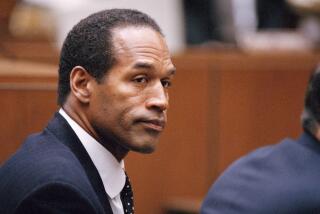Media Aren’t Racially Biased; They’re Just Busy
Times television critic Howard Rosenberg has repeatedly insisted that the media’s obsessive coverage of the slayings of JonBenet Ramsey and Samantha Runnion was due in no small part to the fact that both girls were white (“When Personal Tragedy Becomes Public Spectacle,” Aug. 2). Rosenberg has also decried the media frenzy surrounding the disappearance of Elizabeth Smart, a “golden victim” with skin color “matching that of nearly all the hotshots who have dispatched these [media] hordes to Salt Lake City” (“ ‘POV’ Has Vision to Focus on an Ordinary Family’s Strength,” June 24).
“Meanwhile,” Rosenberg wrote, “similar tragedies besetting blacks and Latinos--and all of the unwealthy--become pit stops (when covered at all) and remain as out of vogue in some circles as sound news judgment.”
On the face of it, the claim that the media lavish a disproportionate amount of attention on abducted or murdered white kids might seem to have merit. The problem is that it’s possible to make any theory about media bias seem plausible if one is willing to ignore enough anomalous data.
Anomalous data like the case of 8-year-old Kevin Shifflett of Alexandria, Va. In April 2000, Kevin was killed in his frontyard by a stranger who shouted racist epithets before slitting the boy’s throat and running away. Kevin’s slaying had all the ingredients that would normally propel a case into national headlines: a brutal stranger-slaying, a racist killer, a suspect on the loose. But there was one wrinkle; Kevin was white, and his alleged killer, Gregory Murphy, who had penned a note before the killing in which he pledged to “kill them racist white kids,” was black. The national media were nearly silent about this case (and even the Virginia media downplayed it).
Compare this with the example of young Sherrice Iverson, the 7-year-old, “unwealthy” African American girl killed in the bathroom of a Nevada casino in 1997 by 18-year-old white kid Jeremy Strohmeyer. The Iverson case made national headlines (and is still talked about in the press).
It should be pointed out that at least one of the victims in the recent kidnapping in Lancaster was nonwhite, but that didn’t stop that case from turning into one of the most publicized in recent memory.
The examples of the Shifflett, Iverson and Lancaster kidnapping cases no more prove a pro-minority bias on the part of the media than the Ramsey, Smart and Runnion cases prove a pro-white bias.
Rosenberg’s bias claim is the mirror image of the media bias claims frequently leveled by conservatives, who complain that the media give a disproportionate amount of coverage to crimes in which minorities are the victims and whites the perpetrators. Conservatives often gripe that white-on-black slayings, though statistically less common than black-on-white killings, receive greater media attention, especially if racial animus is involved.
It is also charged that this same media “bias” applies not only to news coverage of small-scale, interpersonal crimes but also to coverage of large-scale historical crimes and injustices.
Just a few months ago, a friend of mine, a German American survivor of a World War II U.S. internment camp, leveled a similar accusation against the L.A. Times. My friend told me that he feels like his childhood ordeal is purposely ignored by The Times. He pointed out that, in the months after Sept. 11, The Times published a good half dozen stories about America’s history of civil rights violations during times of war, and that, although the internment of Japanese Americans and aliens was mentioned every single time, the story of the 15,000 German noncitizens and their American spouses and children who were also interned in camps was not mentioned once. In fact, in a recent op-ed, former Times contributing editor Robert Scheer actually denied that any Germans were ever interned during WWII. (The Times published a correction of Scheer.)
The internment of 15,000 Germans and the “registration” and house arrest (known as “internment at large”) of some 300,000 others represents one of the largest organized incidents of anti-immigrant discrimination in U.S. history, but The Times consistently fails to mention it, even though World War II-era injustices involving minorities, such as the story of the Mexican laborers who say they were cheated out of 10% of their wages, receive frequent coverage.
I bring all of this up for a reason: I’m sure that Howard Rosenberg would scoff at the notion that any disparity in Times coverage of World War II-era injustices is the result of The Times’ editors’ having some kind of collective affinity or preference for one particular racial group. But this is exactly the kind of charge that he has leveled at other members of the press to explain the supposed disparity in the coverage of murdered and abducted children.
It was an unfair accusation for Rosenberg to make. The news business is, by nature, fickle and arbitrary. Newspaper pages have to be filled; hourlong news shows can’t have dead air. There will always be inconsistencies and inequities in coverage. Sometimes these inequities will appear to favor whites; sometimes they will appear to favor minorities.
A media critic should examine all of the available evidence before charging other journalists with the serious offense of allowing racial favoritism to influence the very difficult choices they are forced to make each day.
Christopher Cole is a writer living in Los Angeles.
More to Read
The complete guide to home viewing
Get Screen Gab for everything about the TV shows and streaming movies everyone’s talking about.
You may occasionally receive promotional content from the Los Angeles Times.






